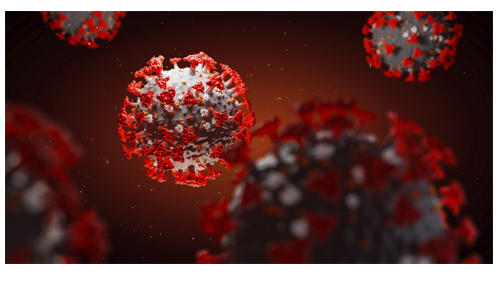Nine months into the pandemic, researchers are starting to figure out a few things. These new insights are hugely important.
Knowing them could make the difference between catching coronavirus or staying healthy.
Remember back to the beginning the pandemic? It seems like a long time ago, doesn’t it?
Back then epidemiologists were extremely worried about coronavirus spreading by people touching contaminated surfaces.
That’s why so many of us regularly disinfected doorknobs, phones, and other high-touch surfaces. Maybe you’re still doing this.
Now, it’s clear that infected surfaces are not coronavirus enemy #1. Study after study shows that the biggest spreader by far of COVID-19 is contaminated air in poorly ventilated, indoor rooms where people congregate.[1][2]
This is where so-called “superspreader” events occur.
An accidental “experiment” at a Dutch nursing home shows the important of strong ventilation. It was described recently in the journal Clinical Infectious Diseases.[3]
One building in the facility had a modern energy-efficient ventilating system that didn’t bring in fresh outside air unless carbon dioxide levels reached a certain threshold. More than half the healthcare workers in this building got COVID-19. Eighty-one percent of the residents became infected.
Meanwhile, the other buildings were less well-insulated and had old-fashioned ventilation systems that brought in fresh air continuously. Not even a single staff member or resident in those buildings contracted the virus.
The most famous superspreader event occurred at the White House on September 26.[4]
President Trump hosted a reception to nominate Judge Amy Coney Barrett to the Supreme Court. The event was featured a crowd of people sitting close together, many not wearing masks. Part of the event was held indoors, where people stood near each other talking.
Afterward, more than two dozen people who either attended the event or came in contact with people who did, tested positive for coronavirus. They included President Trump and First Lady Melania.[5]
The Centers for Disease Control and Prevention has been woefully late in warning the public about airborne transmission. It wasn’t until recently that the CDC even acknowledged it was possible for the virus to spread through the air like it did at the White House.[6]
Knowing the 3 Vs Can Help You Avoid COVID-19
We all know that it’s important to wear a mask when we’re out in public and distance ourselves. But there are other precautions that can help you avoid getting the coronavirus through contaminated air.
Dr. Zeynep Tufekci is an associate professor at the University of North Carolina. She believes that knowing the “three Vs” is crucial:
1.) Venue: Inside is bad. Outside is good. It’s far better eat at a restaurant that has outdoor seating than to sit inside.
A new European study looked at more than 25,000 people who tested positive for the coronavirus. Ninety-four percent of the cases were linked to indoor transmission. The other 6% were associated with outdoor crowds, such as those at sporting events or concerts.[7]
The authors wrote: “The risk of transmission is much lower outside than inside because viruses that are released into the (outdoor) air can rapidly become diluted through the atmosphere.”
2.) Ventilation: Big rooms with plenty of air movement are safer than confined spaces with less ventilation.
3.) Vocalization: Places where people talk, shout, or sing are more dangerous than places where they are quiet. Stay away from anyone who speaks loudly, laughs, or sings.
The bottom line?
Avoid “crowds in closed spaces in close contact, especially if there’s talking or singing,” Dr. Tufekci said.
Washing your hands and disinfecting surfaces is still a good idea. If nothing else, it will help prevent the flu and colds. But it is now clear that your priority should be to avoid crowded indoor spaces where people are talking.
Editor’s Note: Discover the simple ancient health practice that researchers believe may offer a “ray of hope” in the fight against COVID-19. It takes just minutes a day.
Find out why one doctor is doing it himself and is recommending it to all his patients. Get all the details in Independent Healing. To get your copy, go HERE.
Related Articles
Coronavirus: The Heart Effects Are Scary
Why More Coronavirus ICU Patients Are Making It Out Alive
Coronavirus: This Vitamin Deficiency Could Double Infection Risk, Study Finds
[1] https://www.dallasnews.com/news/2020/10/13/why-was-it-news-that-scientists-finally-confirmed-airborne-transmission-of-coronavirus/
[2] https://www.theatlantic.com/health/archive/2020/09/k-overlooked-variable-driving-pandemic/616548/
[3] https://academic.oup.com/cid/advance-article/doi/10.1093/cid/ciaa1270/5898577
[4] https://www.bbc.com/news/election-us-2020-54487154
[5] https://www.nytimes.com/interactive/2020/10/02/us/politics/trump-contact-tracing-covid.html
[6] https://www.washingtonpost.com/nation/2020/09/21/cdc-covid-aerosols-airborne-guidelines/
[7] https://medicalxpress.com/news/2020-10-coronavirus-rare-impossible.html

